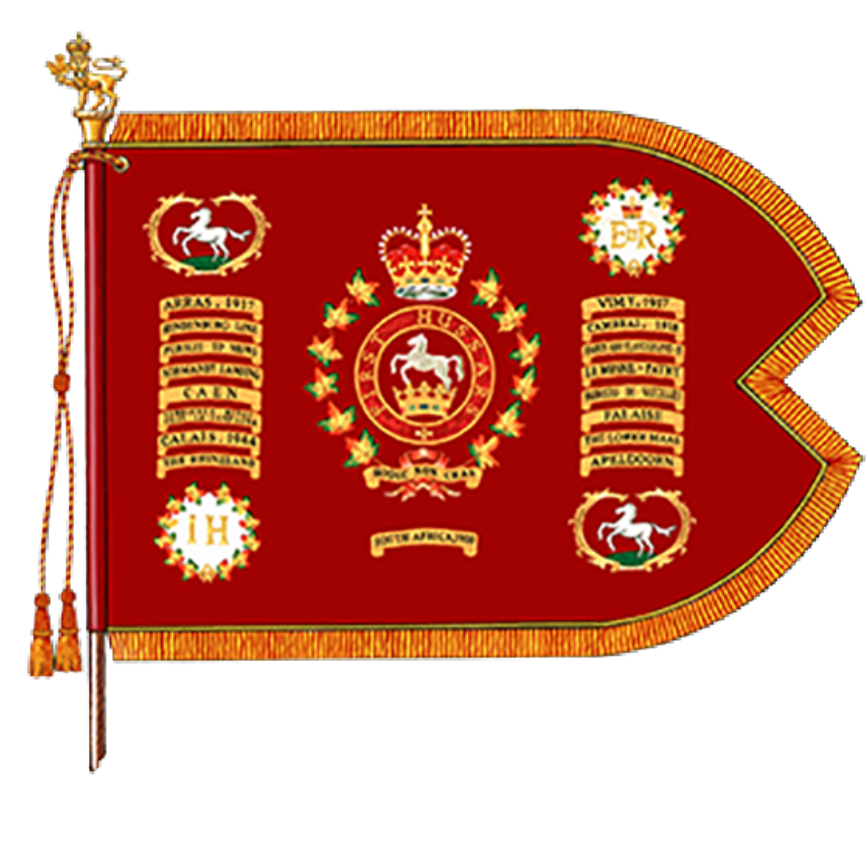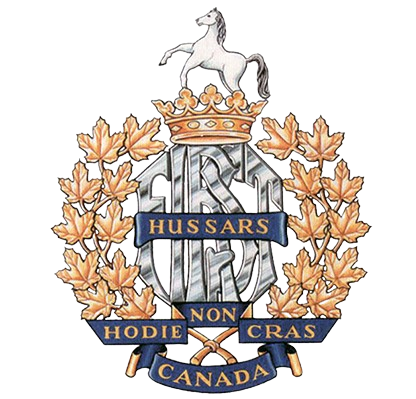Battle Honours
A Proud Past
The 1st Hussars have received 34 Battle Honours throughout its history: 17 of which adorn the Guidon. Battle Honours are given to units which have displayed distinguished achievements during battle.
The Guidon in the Light Cavalry and the Armoured Corps is the counterpart of the Infantry Colour. Originally Guidons were intended as conspicuous rallying points in battle. Each Regiment has only one Guidon, of crimson silk damask, two feet eight inches deep and three feet five inches to the points of the swallow tails. Embroidered and fringed in gold, it is carried on a pike seven feet four inches long with tassels of mixed crimson and gold.
The Guidon of the 1st Hussars has as its center badge the White Horse of Hanover over a Coronet surrounded by the name “FIRST HUSSARS”. All are within the National Wreath and ensigned with the Royal Crown. Beneath is the Regimental Motto “HODIE NON CRAS” (Today Not Tomorrow). In the first canton, or corner, is the abbreviated name of the Regiment “1H” and in the second and third, the White Horse of Hanover. The fourth contains the cipher of Her Majesty Queen Elizabeth II. Emblazoned are 17 of the Regiment’s 34 Battle Honours.
The ceremony of Trooping the Guidon stems from that of Lodging the Guidon and derives its title from a troop or drum call. When Guidons were still used on active service, at each day’s close, they were formally escorted to the safe custody of their overnight lodging in a building or tent. As part of that ceremony the Guidons were borne in slow time through the assembled Regiment to ensure recognition by all ranks in the confusion of battle. The exact drill for this procedure was laid down by Army Order and included “the part to be played by the drummers in beating a troop.”
Traditionally each Guidon was carried by a Cornet, or junior officer, but in 1822 the responsibility was delegated to a Troop Sergeant Major. Today, the honour of carrying the Guidon is entrusted to the senior Master Warrant Officer.
First Hussars Battle Honours (Those in bold are carried on the Guidon)
South Africa 1900
SOMME 1916
Scarpe 1918
Flers-Courcelette
Drocourt-Queant
Ancre Heights
Hindenburg Line
Arras 1917, 1918
Canal du Nord
Vimy 1917
Cambrai 1918
Amiens
Pursuit to Mons
France and Flanders 1915-1918
Normandy Landing
Falaise Road
Putot-en Bessin
Quesnay Wood
Le Mesnil-Patry
The Laison
Caen
Chambois
The Orne
Calais 1944
Bourguebus Ridge
The Lower Maas
Faubourg de Vaucelles
The Rhineland
Verrieres Ridge – Tilly – la – Campagne
The Hochwald
Apeldoorn
Falaise
Bad Zwischenahn
North West Europe 1944-1945
Afghanistan

